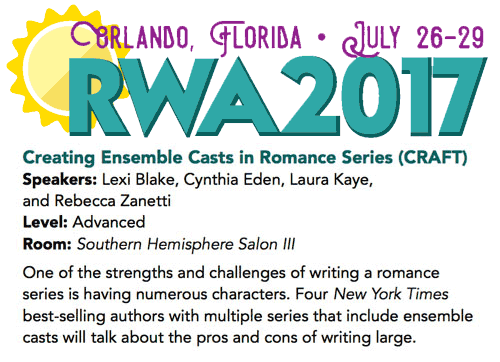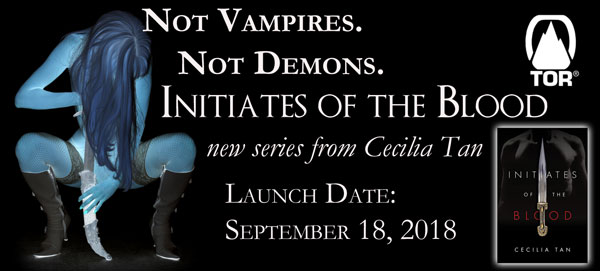
I’m at the RWA national conference in Orlando right now, where there’s always something more to think about, learn, or analyze about writing or romance publishing. In particular one writing craft panel I wanted to highlight was yesterday I attended a great panel workshop given by four New York Times bestselling authors: Lexi Blake, Cynthia Eden, Laura Kaye, and Rebecca Zanetti. The topic was on creating a large cast of characters to carry a series and the room was packed.
The discussion ranged over various details from the nuts and bolts of creating a series “bible” to keep all the details right from book to book (character eye color, favorite catch phrases, back stories, each character’s hidden secret or flaw, etc) to developing secondary characters into primary ones when “their turn for a book” comes.

I didn’t transcribe the entire panel since I was trying to focus on absorbing things relevant to me, but two questions in particular I got down almost every word, and I’m posting to share it with everyone.
Laura Kaye acted as moderator, asking the leading questions for the panel and then finishing off giving her own answer.
First she asked the panelists to describe the pros and cons of working with large casts.
Cynthia Eden: We’ve all heard the expression that no man or woman is an island? Characters don’t exist in isolation. You’re never just writing about one individual. You are by circumstance always writing about a cast of characters. You give them an instant background with their family and friends. With my romantic suspense novels I like to use teams. I write FBI teams. You’re going to need a lead investigator, a profiler, an ME, etc. You’re going to need all these people. So that’s a major pro. And any cast leads to sequels. That’s the biggest pro because it has your reader eager to go on to the next book.
Lexi Blake: Pro of a large cast? It’s fun! I like to write a lot of dialogue and you get a lot of dialogue when you have a big ol’ cast of characters. The con is… I guess there isn’t one. Well, maybe it’s that you have to make each character unique. That can be a challenge. (But that’s fun, too.)
Rebecca Zanetti: A large cast is great to show characterization. You act differently with different people. I have one sister I tease like crazy and one that I can’t. You can show different facets of a character and that’s one I like a lot. Also the slow burn character, I love. That person who shows up in book one and they build up for a long time before they get their story. You can develop them over a series. The con is you sometimes get too many people on a page. Even if you’re on book 4 or 5 of a series, you hope new readers are picking them up. You don’t want to confuse that new reader with too many new characters all at once.
Lexi: Well, and as you write the books they get longer because you keep having to put everyone’s favorite characters in there. Then you have to do the backyard BBQ scene to get them all in!
Laura Kaye: I agree, on the backyard BBQ. The thing that is great about having all these characters is you have the built in relationships where it’s easy to have humor, and it’s easy to have stakes because there are many people who could be hurt or feel lied-to or betrayed. Lots of emotional hooks for your readers. Not just for your sequels where they buy into a beloved secondary character, but for the tertiary characters who can manage to hook interest and get pulled into the story. You can expand a series if it takes off and starts doing well. It gives you the flexibility to do spin-offs. The cons are that your POV characters can’t just absorb a tennis match of other people talking. They have to be engaged in the conversation. Then there’s the giant pronoun problem when you have, say, five military guys on your team planning a mission and you have to figure out the mechanics of writing that dialogue so it’s not monotonous to the reader. The other con is if you’re going with a traditional publisher and you have 5 main characters, but your publisher stops after three books. You can end up with disappointed readers on your hands.
What are some tips for developing such a large number of characters? What are some tips for distinguishing them?
Rebecca: One thing I like is nicknames, if he calls her honey or sweetcheeks makes a difference. Also their motivations. If you play a joke on one friend, they laugh, another one never forgives you. They’re different. There are the little tidbits you put in. I have one guy that likes grape energy drinks and if I don’t put that in readers will write and say does he not like those anymore? Also their wounds. What hurt this guy, what is he still afraid of?
Lexi: if you don’t know those characters, the reader won’t know them. I think you don’t have to know everything before you start, but you have to know what makes them laugh, what makes them cry. I’ve written a lot of small town romance. And getting to know the neighbors and walking through the town can pull you in. But even an office building can have a sense of place. Put your characters around a table and see who talks first. If you’re just putting traits in a notebook and there’s no real emotion behind them it’s going to show. I love using dialogue. Some speak, fast, some slow, and you need to be able to hear them in your head.
Cynthia: I like to work with opposites on a team. You’ll have one guy who’s the hothead and always jumps right in. Then I have a team member who likes to sit back and get all the info before jumping in. So she and the first guy are going to have a clash. My action-first character, if he’s angry, he’s not just going to sit still. He’ll be pacing and clenching his fists and all that. All this body language that this character is doing with reveal his personality. The one who is the analytical sort? She’s not going to just kick in a door. She’ll be trying to talk the person down. Those personality styles lead me into what they should do in each scene. You don’t want them doing something that isn’t their normal nature without a really, really good explanation. Be aware, though, I’ve had New York editors tell me that the way I talk isn’t real, people don’t say that. I’m Southern. Something that seems so normal to me was something they didn’t like. But I think bringing in realistic dialect is a great way to distinguish the characters.
Laura: Think of it as a shorthand for your character. I learned a lot about creating unique characters from reading JR Ward’s Black Dagger Brotherhood series. One is the blind king who wears the weird sunglasses. And one is the sarcastic one with the dragon tattoo who sucks on lollipops all the time. Then there’s the black-eyed, scarred one who is soulless and never speaks. I don’t even have to use their names: they’re immediately distinct. And when all twelve are in a room having a briefing session, you don’t have to use their names, because you know when so quickly from their distinguishing characteristics who’s who. Also, what are things that make the reader see them as endearing or real, that make the reader fall in love with that person? That grape energy drink or they’re a dog-lover or whatever. The more you can create those personal things the better, beyond scars and tattoos, beyond eye color and hair color. I have a lot of guys who swear but they can’t all say “Aw, hell.” Only one of them can say that and the other guys have to say something else.
As usual, the conference has been fantastic. If you are writing romance, or any kind of commercial fiction, I highly recommend attending one of these if you can afford it. In romance, I really feel I can’t afford *NOT* to be here!


Thanks for sharing! Sounds like it was a very helpful panel discussion.
You’re welcome!